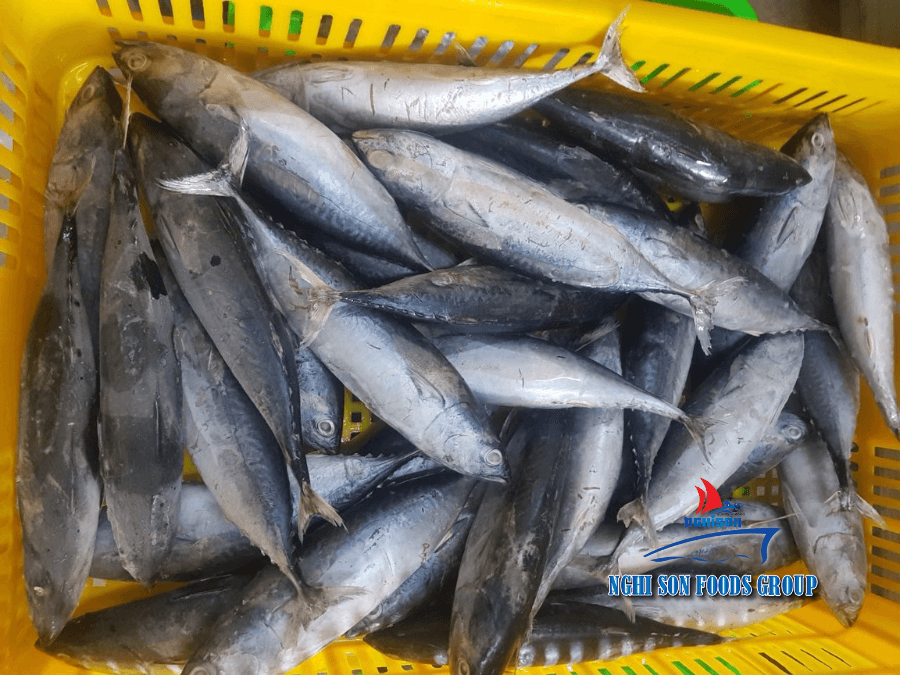What is Bonito Tuna?
Bonito tuna, scientifically known as Sarda sarda, is a pelagic fish species found in temperate and tropical waters around the world. It belongs to the mackerel family, Scombridae, which includes other well-known species like tuna and mackerel. Bonito is characterized by its streamlined, torpedo-like body, designed for swift swimming. It typically has a dark-blue to greenish back, which helps it blend into the ocean depths and a silver-white belly. The species exhibits countershading, a form of camouflage common in marine life.
In terms of taste and texture, bonito tuna offers a unique culinary experience. Its flesh is firm, and meaty, and ranges in color from pale pink to deep red, depending on factors like diet and age. This firm texture makes it ideal for various cooking methods, from grilling and broiling to searing and sashimi preparation. Its flavor is often described as robust, with a pronounced umami quality. The umami notes are reminiscent of smoked wood, soy sauce, and mushrooms. These characteristics make bonito a sought-after ingredient in many cuisines, where its bold taste can enhance dishes ranging from simple salads to complex sushi rolls.
Different Types of Bonito
While the term “bonito” is often used generically to refer to various species within the Sarda genus, there are specific types of bonito that are recognized for their culinary and ecological significance:
- Skipjack Bonito (Katsuwonus pelamis): Skipjack is perhaps the most well-known bonito species. It’s smaller in size compared to other tunas, typically growing to around 30 inches (75 cm) in length and weighing about 20 pounds (9 kg). Skipjack is known for its mild flavor and is often used in canned tuna products. It’s an economically important species in the global seafood industry.
- Atlantic Bonito (Sarda sarda): Atlantic bonito is a distinct species found in the Atlantic Ocean and the Mediterranean Sea. It’s larger than skipjack, with some individuals reaching up to 30 pounds (14 kg). Atlantic bonito is prized for its more pronounced and flavorful taste. It’s a popular catch among recreational anglers and commercial fishermen in the Mediterranean region.
- Pacific Bonito (Sarda chiliensis): Pacific bonito is found in the eastern Pacific Ocean, from California to Chile. It’s similar in size and taste to skipjack but is primarily targeted by recreational anglers rather than commercial fisheries.
Health Benefits
Bonito tuna offers a range of health benefits due to its nutritional composition:
- Protein: Bonito is an excellent source of high-quality protein, providing about 25 grams of protein per 3.5-ounce (100-gram) serving. Protein is essential for muscle building, tissue repair, and overall body function.
- Omega-3 Fatty Acids: Bonito is rich in omega-3 fatty acids, particularly eicosapentaenoic acid (EPA) and docosahexaenoic acid (DHA). These essential fatty acids are known for their cardiovascular benefits. They can help reduce the risk of heart disease, lower blood pressure, and improve cholesterol levels.
- Vitamins and Minerals: Bonito contains essential vitamins and minerals, including B vitamins (B1, B2, B3, B6, and B12), selenium, and potassium. B vitamins are crucial for various bodily functions, including energy metabolism and nerve health. Selenium is an antioxidant that supports immune function, and potassium helps regulate blood pressure and fluid balance.
- Low in Calories: Bonito is relatively low in calories, making it a suitable choice for those looking to manage their weight while enjoying a nutrient-dense protein source.
Culinary Uses
The culinary versatility of bonito tuna makes it a favorite ingredient in various cuisines:
- Sashimi and Sushi: In Japanese cuisine, bonito tuna is highly regarded for its sashimi and sushi applications. Katsuo sashimi, thinly sliced bonito, is prized for its fresh, meaty flavor. Bonito is also used to make katsu sushi, where it’s typically seared briefly to enhance its smoky taste.
- Grilling and Broiling: The firm flesh of bonito stands up well to grilling and broiling. This cooking method caramelizes the surface and intensifies its umami flavor. In Mediterranean countries like Spain and Italy, grilled bonito is often served with olive oil, lemon, and herbs.
- Smoking: Bonito tuna can be smoked to create a smoky, flavorful product. Smoked bonito is commonly used in salads, sandwiches, and pasta dishes, adding a unique depth of flavor.
- Canned Tuna: Bonito is a popular choice for canned tuna products. The canning process preserves the fish’s flavor and texture, making it a convenient pantry staple for salads, sandwiches, and casseroles.
- Dashi: In Japanese cuisine, bonito tuna is an essential ingredient in dashi, a flavorful broth used as a base in many dishes. Dashi is often made by simmering bonito flakes (known as katsuobushi) with kombu (seaweed), creating a savory, umami-rich stock.
- Tataki: Tataki is a Japanese dish featuring a thinly sliced bonito that is quickly seared on the outside while the interior remains raw. It’s typically served with soy sauce, grated ginger, and garlic, allowing diners to appreciate the contrast between the seared exterior and the delicate, raw interior.
Sustainability
Sustainability is a crucial concern when it comes to sourcing bonito tuna. Overfishing and unsustainable fishing practices can lead to declines in bonito populations and negatively impact marine ecosystems. To promote sustainability, consumers can:
- Look for Certifications: Seek out seafood products with certifications such as the Marine Stewardship Council (MSC) label, which indicates responsible fishing practices and sustainable sourcing.
- Know the Source: Research the source of your bonito tuna, whether it’s fresh or canned. Understanding the fishing methods used and the sustainability practices of the brand or fishery can help you make informed choices.
- Choose Pole and Line: When possible, opt for bonito tuna caught using pole and line fishing methods. This method minimizes bycatch and reduces the environmental impact.
- Support Regulations: Support government regulations and policies that aim to protect bonito populations and maintain healthy ocean ecosystems.
By making sustainable choices, consumers can contribute to the preservation of bonito tuna populations and the overall health of the oceans.
Differences from Other Tuna
Bonito tuna differs from other tuna species in several ways:
- Flavor Intensity: Bonito tuna is known for its more robust and intense flavor compared to milder tuna varieties like albacore or yellowfin. Its bold, smoky taste sets it apart in culinary applications.
- Size: Bonito tuna is typically smaller in size than some other tuna. Skipjack bonito, for example, is significantly smaller than bluefin tuna, which can grow to enormous sizes.
- Texture: Bonito’s meaty, firm texture makes it a favorite for grilling and searing. Other tunas, such as yellowfin, may have a slightly softer texture.
- Culinary Uses: Bonito is often associated with specific culinary traditions, such as Japanese cuisine and Mediterranean cooking. Its unique flavor makes it a preferred choice in dishes where its taste can shine.
Canned Bonito
Canned bonito tuna is a convenient and versatile ingredient in many kitchens. The canning process involves cooking the fish and sealing it in a can with various mediums, including oil, water, or brine. This preservation method ensures a longer shelf life, making canned bonito readily available for a wide range of recipes. The choice of medium (e.g., oil or water) can influence the taste and texture of the canned product. Oil-packed bonito tuna tends to be richer and more flavorful, while water-packed options are lighter. Both types are commonly used in salads, sandwiches, pasta dishes, and casseroles.
When selecting canned bonito, consider the culinary context in which you plan to use it, as different brands and packing mediums may suit specific recipes better. Additionally, check the label for information on the sourcing and sustainability of the product to align with your preferences.
Cultural Significance
Bonito tuna holds cultural significance in various regions around the world:
- Japan: In Japan, bonito tuna is an integral part of the culinary heritage. It plays a central role in traditional dishes like dashi, a foundational broth used in countless Japanese recipes. The preparation of bonito flakes, known as katsuobushi, is a highly specialized art form. Additionally, bonito is featured in tataki, a dish that highlights its fresh, raw interior and smoky seared exterior.
- Mediterranean Region: In countries bordering the Mediterranean Sea, such as Spain, Portugal, and Italy, bonito is celebrated as a prized catch. Grilled or broiled bonito is a common preparation, often enjoyed with simple yet flavorful accompaniments like olive oil, lemon, and herbs. The fish is also canned for use in various Mediterranean dishes, including salads and pasta.
- Festivals: Some regions host festivals and events dedicated to bonito fishing and consumption. These celebrations reflect the cultural importance of the fish in local traditions and cuisine.
Catch and Fishing Methods
The methods used to catch bonito tuna can vary, with some being more environmentally friendly than others:
- Purse Seine Nets: Purse seine nets are often used in commercial fishing for bonito. They involve encircling a school of fish with a large net, which is then drawn closed like a drawstring purse. While effective in catching large quantities, purse seine nets can result in bycatch, including non-target species.
- Longline Fishing: Longline fishing uses a long line with baited hooks to catch bonito. This method is more selective, as it targets specific fish species and reduces bycatch. However, it can still have an impact on non-target species like sea turtles and seabirds.
- Pole and Line Fishing: Pole and line fishing is considered one of the most environmentally friendly methods for catching bonito. It involves using a fishing rod and baited hooks to catch fish individually, reducing the risk of bycatch and minimizing the ecological impact.
Sustainable fishing practices aim to mitigate the environmental impact of these methods and promote responsible harvesting of bonito tuna.
Fresh vs. Frozen
The choice between fresh and frozen bonito tuna depends on various factors:
- Fresh Bonito: Fresh bonito is often preferred when the goal is to highlight the fish’s delicate texture and bold flavor, as in sashimi or sushi. Look for fresh bonito at seafood markets and specialty fishmongers.
- Frozen Bonito: Frozen bonito can be an excellent choice for cooked dishes like grilling, broiling, or searing. Properly frozen bonito can retain its quality and flavor, making it a convenient option for home cooks. When selecting frozen bonito, ensure that it has been handled and stored correctly to maintain its freshness.
- Thawing: When working with frozen bonito, it’s important to thaw it properly. Slowly thawing the fish in the refrigerator is the safest method to preserve its texture and flavor. Avoid thawing in warm water or at room temperature, as this can lead to undesirable changes in the fish’s quality.
Substitute for Other Fish
Bonito tuna’s firm, meaty texture and bold flavor make it a versatile substitute for other fish in various recipes:
- Swordfish: Bonito can be a suitable replacement for swordfish in recipes that call for its dense, meaty texture. Grilled or broiled bonito can offer a similar taste and mouthfeel.
- Mahi-Mahi: For dishes that require the firmness of mahi-mahi, bonito can be used interchangeably. Its robust flavor can complement various preparations.
- Tuna: While bonito is technically a type of tuna, it can be used as a flavorful alternative to other tuna species, such as albacore or yellowfin, depending on the desired taste and texture.
- Mackerel: In some recipes, bonito can also stand in for mackerel, thanks to its meaty texture and smoky undertones.
Experimenting with bonito as a substitute can introduce new flavors and dimensions to your favorite dishes.
Allergies and Mercury
As with all seafood, it’s essential to be aware of potential allergies and mercury content:
- Fish Allergies: Some individuals have allergies to fish, including bonito tuna. Symptoms of a fish allergy can range from mild skin reactions to severe respiratory distress. Those with known fish allergies should avoid bonito and other seafood products.
- Mercury Content: Bonito tuna is generally considered to have lower mercury levels compared to larger tuna species like bluefin or bigeye tuna. This makes bonito a relatively safer choice for consumption, especially for vulnerable populations such as pregnant women and young children. However, it’s essential to consume all seafood in moderation to manage mercury exposure.
Individuals with allergies or concerns about mercury should consult with a healthcare professional or allergist for personalized guidance.
Flavor Profile
Bonito tuna’s flavor profile is its defining characteristic, attracting chefs and food enthusiasts worldwide:
- Umami: The umami taste in bonito is exceptionally pronounced, contributing to its savory, rich flavor. Umami is often described as the “fifth taste” alongside sweet, salty, sour, and bitter. It imparts a depth and complexity that makes bonito a sought-after ingredient.
- Smokiness: Bonito’s smoky undertones are reminiscent of wood smoke and charred meat. This quality enhances its appeal for grilling and broiling methods, where the smokiness can be intensified.
- Soy Sauce-Like Notes: Some describe bonito’s flavor as reminiscent of soy sauce or dried mushrooms. These complex, earthy notes add depth to dishes where bonito is used as a primary flavor.
- Meaty and Robust: Overall, bonito tuna is celebrated for its meaty and robust character. Its bold flavor can stand up to a range of seasonings and cooking techniques, making it a versatile ingredient in various cuisines.
Price and Availability
The price and availability of bonito tuna can vary by region, season, and demand:
- Coastal Areas: Coastal regions with active fishing industries may have more consistent access to fresh bonito. Prices may also be lower in these areas due to proximity to the source.
- Inland Regions: Inland regions or areas farther from the coast may have less access to fresh bonito, which can lead to higher prices. In these areas, bonito is often available in canned or frozen forms.
- Seasonality: Bonito tuna has seasonal variations in availability, with different regions experiencing peak seasons at different times of the year. Being aware of these seasonal patterns can help consumers plan their purchases.
- Demand: Demand for bonito tuna, driven by factors such as culinary trends and consumer preferences, can influence both price and availability.
To make informed choices and get the best value, consumers should consider local availability, seasonality, and their specific culinary needs when purchasing bonito tuna.
Cooking Tips
Cooking bonito tuna to perfection requires some attention to detail:
- Temperature Control: When grilling, broiling, or searing bonito, precise temperature control is crucial. High heat is typically used to sear the exterior while keeping the interior rare or medium-rare.
- Seasoning: Bonito’s bold flavor pairs well with a variety of seasonings. Common choices include olive oil, lemon juice, fresh herbs, garlic, and soy sauce. The goal is to enhance the fish’s natural taste without overpowering it.
- Sashimi and Sushi: When preparing bonito for sashimi or sushi, it’s essential to use extremely sharp knives to achieve thin, even slices. Chilled serving platters or dishes can help maintain the freshness of the fish.
- Marination: Marinating bonito for a short time before cooking can infuse it with flavor. However, due to its firm texture, bonito does not require extended marination.
- Doneness: Pay close attention to the cooking time to avoid overcooking the bonito, which can result in a dry and less flavorful dish. Bonito is often served rare in the center, allowing its unique taste and texture to shine.
- Accompaniments: Consider pairing bonito with complementary ingredients, such as citrus fruits like oranges or grapefruit, fresh salads, or grilled vegetables, to create well-balanced and visually appealing dishes.
These cooking tips can help you make the most of bonito tuna’s distinctive qualities and create memorable culinary experiences.















Reviews
There are no reviews yet.